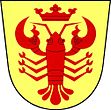Rovensko u Zábřeha
| Rovensko | ||||
|---|---|---|---|---|
|
||||
| Basic data | ||||
| State : |
|
|||
| Region : | Olomoucký kraj | |||
| District : | Šumperk | |||
| Area : | 741 ha | |||
| Geographic location : | 49 ° 55 ' N , 16 ° 52' E | |||
| Height: | 298 m nm | |||
| Residents : | 829 (Jan. 1, 2019) | |||
| Postal code : | 789 01 | |||
| License plate : | M. | |||
| traffic | ||||
| Street: | Olšany - Zábřeh | |||
| structure | ||||
| Status: | local community | |||
| Districts: | 1 | |||
| administration | ||||
| Mayor : | Stanislav Doleček (as of 2009) | |||
| Address: | Rovensko 59 789 01 Zábřeh |
|||
| Municipality number: | 540919 | |||
| Website : | rovensko.zabrezsko.cz | |||
Rovensko (German Rowenz ) is a municipality in the Czech Republic . It is located three kilometers north of Zábřeh and belongs to the Okres Šumperk .
geography
Rovensko is located at the drop of the Drozdovská vrchovina ( Drosenauer Uplands ) to the Müglitzer Furche ( Mohelnická brázda ) on the brook Rakovec. The Hraniční strouha trench runs to the east. To the west lies the Březná Nature Park. In the north rises the Homůlka (332 m), southwest of the Ovčary (466 m), in the west of the Háječek (471 m) and in the north-west the Homole (516 m).
Neighboring places are Postřelmůvek and Chromeč in the north, Šikulův Mlýn, Bludovský Mlýn, Bludov and Sudkov in the northeast, Postřelmov and Pazderna in the east, Nový Dvůr, Kopanice, Lesnice and Leština in the southeast, Levenov, Zábřeh and Krumpach in the south Southwest, Václavov and Svébohov in the west and Zborov in the northwest.
history
Rovensko was first mentioned in a document in 1373, when the owner of the Hohenstadt and Eisenberg dominions , Zdenko von Sternberg , wrote over the income from several villages to his stepmother Machná z Běliny. After the male line of the Sternberger had expired, the goods fell back to the Margraviate of Moravia . In 1397 Margrave Jobst of Moravia awarded Peter I of Kravarn . In 1411 Rovensko and other villages were obliged to buy Hohenstadt beer before the Hohenstadt City Court and, apart from the blacksmiths, the practice of handicrafts was prohibited. In 1431 Archduke Albrecht II's troops set fire to the area. Between 1437 and 1442 the Tunkl von Brníčko acquired large areas of northern Moravia, including Hohenstadt . The Lords of Tunkl stood at Georg von Podebrad's side . During the Hungarian-Bohemian War, the Hohenstadt rule was therefore devastated by Hungarian troops. At the end of the 15th century, the Tunkl had a large system of ponds, dams and ditches built along the March . The town pond and the large and small Zadworschitzer pond (Závořické rybníky) were built southwest of Rovensko. The village of Závořice, which has been documented since 1351, died out at that time. In 1491 and 1493 there was an uprising of the subjects because of the compulsory labor in pond construction. George d. Ä. Tunkl was injured and died as a result. In 1516 there were only six properties in Rovensko. In the Hohenstädter Urbar from 1585, 32 farms are shown for Rovensko, including 26 farmers, four gardeners and two residents. During the Thirty Years War, the area was devastated by the Swedes from 1635 onwards. The Liechtensteiners brought German settlers into the country for resettlement. Rowensk's oldest local seal is from 1787. A school was built at the beginning of the 19th century. In 1839 the village consisted of 96 houses and 709 inhabitants. A clay mine was operated on the way to Svébohov at this time. In addition, iron ore was mined on a small scale.
After the abolition of patrimonial Rovensko / Rowenz formed a political municipality in the Hohenstadt district from 1850. In the cholera epidemic of 1855, 50 people died. In 1880 there were 685 people living in the village and in 1910 there were 764. In 1899 Petr Adámek founded a small roofing felt factory in Rovensko. In 1921, 752 people lived in the village's 126 houses, 733 of whom were Czech, ten German and six foreigners. In 1930 Rovensko had 746 inhabitants, 742 of whom were Czech.
After the Munich Agreement , the village was added to the German Reich in 1938 and belonged to the Hohenstadt district until 1945 . In the Sudeten German elections to the National Socialist Reichstag , the NSDAP candidates were nodded on December 4, 1938 in Rowenz with 90% of the vote. In 1939 Rowenz had 787 inhabitants. Arrests were made by the Gestapo in 1944 after an illegal resistance organization in North Moravia was exposed through treason. On May 7, 1945, the German troops withdrew. A day later the Red Army marched in and the Germans opened fire from Schwilbogen , killing three people.
After the end of the Second World War, the village came back to Czechoslovakia. At the beginning of 1961, the Okres Zábřeh was dissolved and Rovensko was assigned to the Okres Šumperk. In 1969, 723 people lived in the 187 houses of the community. Between 1976 and 1991 Postřelmůvek was incorporated.
Community structure
No districts are shown for the municipality of Rovensko.
Attractions
- Chapel of the Mariä Wiegenfest, built in 1856
- Prayer column, erected in the first half of the 19th century
- Hraniční strouha, the moat was part of the from 1489 under Johann d. Ä. Tunkl pond system created along the March
- Folk style farmsteads from the middle of the 19th century
- House of the dead
Individual evidence
- ↑ Český statistický úřad - The population of the Czech municipalities as of January 1, 2019 (PDF; 7.4 MiB)


